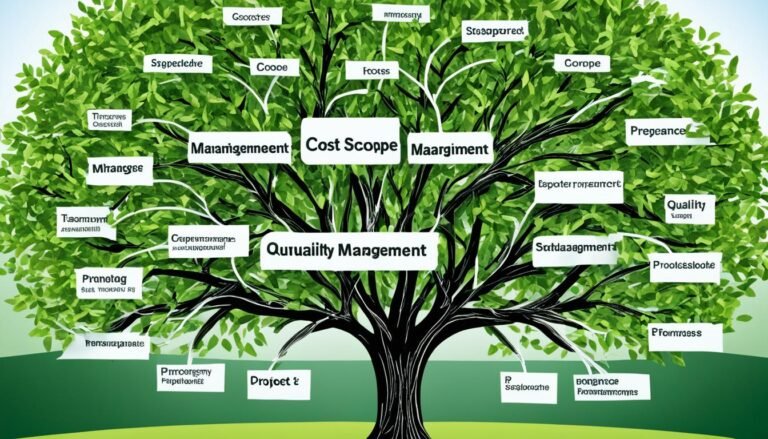Project Governance: Ensuring Structure and Accountability
Project governance plays a crucial role in the success of any project, providing the necessary structure and accountability to ensure its smooth execution. By establishing a governance framework, organizations can effectively define the roles, responsibilities, and decision-making processes that govern project activities. This not only promotes transparency and communication but also mitigates risks and ensures that projects are delivered on time and within budget.
In this discussion, we will explore the key elements of effective project governance, the role of project managers in governance, and the measures taken to ensure accountability.
So, let's dive into the world of project governance and discover how it ensures structure and accountability, ultimately leading to successful project outcomes.
Key Takeaways
- Project governance provides structure, processes, and guidelines for effective project management.
- Effective governance promotes collaboration among stakeholders from different departments and organizations.
- Accountability measures are crucial for ensuring transparency and compliance with guidelines and standards.
- Establishing a governance framework involves considering roles and responsibilities, decision-making processes, and communication channels.
The Importance of Project Governance
Project governance plays a crucial role in ensuring the success and accountability of any project. It provides the structure, processes, and guidelines necessary for effective project management. One of the key aspects of project governance is the importance of collaboration.
In today's complex business environment, projects often involve multiple stakeholders from different departments, locations, and even organizations. Effective collaboration among these stakeholders is essential to align objectives, share information, and make informed decisions.
Collaboration within project governance brings several benefits. Firstly, it promotes transparency and communication, allowing stakeholders to have a clear understanding of project goals, progress, and risks. This helps in avoiding misunderstandings and conflicts while fostering a sense of collective ownership and responsibility.
Secondly, collaboration enables the pooling of diverse skills, knowledge, and expertise from different stakeholders. This leads to better problem-solving, innovative ideas, and increased efficiency in project execution.
Moreover, collaboration encourages a culture of shared learning and continuous improvement. Through open dialogue and feedback, stakeholders can identify and address issues promptly, learn from mistakes, and implement best practices. This not only enhances project outcomes but also builds a foundation for future projects.
Defining Project Governance
Project governance is a critical component of successful project management, providing the framework and oversight necessary to ensure proper project execution and delivery. Defining project governance is essential to establish clear roles, responsibilities, and decision-making processes within a project. It involves creating a structure that outlines how the project will be governed, including the establishment of a project board or steering committee responsible for making key strategic decisions.
The definition of project governance varies depending on the organization and project complexity. However, it typically involves the identification of project stakeholders, the establishment of project objectives and success criteria, and the development of a governance framework that outlines the processes, procedures, and tools to be used throughout the project's lifecycle.
Implementing project governance can present several challenges. One challenge is ensuring that the governance structure aligns with the organization's overall governance framework. Another challenge is defining the appropriate level of governance for the project, considering factors such as project size, complexity, and risk. Additionally, stakeholders' involvement and commitment to the governance structure can also pose implementation challenges.
To overcome these challenges, it is important to engage key stakeholders early in the process, clearly communicate the purpose and benefits of project governance, and continuously review and adapt the governance structure as the project progresses. By defining project governance effectively and addressing implementation challenges, organizations can enhance project outcomes and ensure successful project delivery.
Key Elements of Effective Governance
Effective project governance requires two key elements: a well-defined governance structure and robust accountability measures.
The governance structure outlines the roles, responsibilities, and decision-making processes within the project, ensuring clear lines of authority and communication.
Accountability measures establish mechanisms to track progress, identify and address issues, and hold individuals and teams responsible for their actions.
Governance Structure
A well-designed governance structure is essential for ensuring accountability and facilitating effective decision-making in any project. It provides a clear framework for governing the project and establishes the roles, responsibilities, and relationships among key stakeholders.
Here are the key elements of an effective governance structure:
- Clear objectives and scope: Clearly defining the project's objectives and scope helps align the governance framework with the project's goals.
- Roles and responsibilities: Assigning clear roles and responsibilities to project stakeholders ensures accountability and promotes effective decision-making.
- Decision-making processes: Establishing transparent decision-making processes enables timely and informed decision-making.
- Communication and reporting: Effective communication and reporting channels ensure that project information is shared promptly and accurately.
- Governance implementation: Regular monitoring and review of the governance structure help identify areas for improvement and ensure its effective implementation.
Accountability Measures
To ensure accountability and promote effective governance, implementing robust accountability measures is crucial. These measures help organizations establish a framework of responsibility and transparency, ensuring that all stakeholders are held accountable for their actions and decisions. Accountability measures not only promote transparency but also help identify and address any deviations or non-compliance with established guidelines and standards. They provide a system of checks and balances to monitor progress, mitigate risks, and ensure that project objectives are met. To illustrate the importance of accountability measures, consider the following table:
| Accountability Measure | Purpose | Benefits |
|---|---|---|
| Regular progress reports | Monitor project progress | Keep stakeholders informed |
| Performance metrics | Measure project performance | Identify areas for improvement |
| Audit trails | Track project activities | Ensure compliance and traceability |
| Clear roles and responsibilities | Define accountabilities | Minimize confusion and conflicts |
| Risk management framework | Identify and manage risks | Mitigate potential issues |
Establishing a Governance Framework
When establishing a governance framework for a project, several key components need to be considered. These components include:
- Defining the roles and responsibilities of project stakeholders
- Outlining the decision-making process
- Establishing communication channels
However, implementing a governance framework can also present challenges, such as:
- Resistance to change
- Conflicting priorities.
Framework Components
Establishing a governance framework involves defining the key components that will provide structure and accountability to a project. These framework components are essential for effective project governance and adherence to governance principles. Here are five important components to consider:
- Roles and Responsibilities: Clearly defining the roles and responsibilities of project stakeholders ensures accountability and prevents confusion.
- Decision-Making Authority: Establishing a clear decision-making process and assigning decision-making authority helps streamline project progress.
- Communication Channels: Identifying the communication channels and protocols facilitates effective communication among project team members.
- Performance Metrics: Setting performance metrics enables project monitoring and evaluation, ensuring that project goals are met.
- Risk Management Plan: Developing a comprehensive risk management plan helps identify and mitigate potential risks throughout the project lifecycle.
Roles and Responsibilities
Continuing the discussion on project governance framework components, one crucial aspect that ensures accountability and clarity is the establishment of clear roles and responsibilities for project stakeholders.
Defining boundaries and ensuring compliance are key in this process. Clear roles and responsibilities provide project team members with a clear understanding of their individual tasks and obligations, allowing them to work efficiently towards project objectives.
By defining boundaries, project stakeholders have a clear understanding of their decision-making authority and the limits of their responsibilities. This helps prevent confusion, duplication of efforts, and potential conflicts.
Furthermore, establishing roles and responsibilities also ensures compliance with organizational policies, procedures, and regulatory requirements. This fosters a culture of accountability and helps mitigate risks associated with non-compliance.
Implementation Challenges
Implementing a governance framework for a project can present various challenges that organizations must overcome to ensure its successful establishment. Some of the implementation challenges and obstacles that organizations may face include:
- Resistance to change: Employees may be resistant to adopting new processes and procedures associated with the governance framework.
- Lack of clarity: Unclear roles and responsibilities can lead to confusion and hinder the implementation of the governance framework.
- Resource constraints: Limited resources, such as budget and personnel, can pose challenges in implementing the necessary changes.
- Communication gaps: Inadequate communication channels and ineffective communication can hinder the understanding and acceptance of the governance framework.
- Lack of leadership support: Without strong leadership support, it can be difficult to drive the implementation process and gain buy-in from stakeholders.
To overcome these challenges, organizations should prioritize change management strategies, provide clear guidance and training, allocate sufficient resources, improve communication channels, and ensure leadership commitment and involvement.
The Role of Project Managers in Governance
Project managers play a crucial role in ensuring effective project governance through their expertise in planning, execution, and oversight. They are responsible for overseeing the entire project lifecycle, from initiation to closure, and ensuring that all project activities align with the organization's goals and objectives. Project managers act as the bridge between the project team and the stakeholders, ensuring that everyone is on the same page and working towards the same goals.
One of the key responsibilities of project managers in governance is to provide project oversight. This involves monitoring the progress of the project, identifying any potential issues or risks, and taking appropriate actions to mitigate them. Project managers also play a vital role in ensuring role effectiveness within the project team. They are responsible for assigning tasks and responsibilities to team members, ensuring that everyone understands their roles and responsibilities, and providing the necessary support and guidance to ensure successful project execution.
To illustrate the importance of project managers in governance, let's consider the following table:
| Role | Responsibilities |
|---|---|
| Project Manager | Planning and executing the project, overseeing project activities, managing project risks, ensuring stakeholder engagement |
| Team Members | Completing assigned tasks, collaborating with other team members, providing regular updates on progress |
| Stakeholders | Providing input and feedback, making decisions, ensuring project alignment with organizational objectives |
As shown in the table, project managers play a central role in coordinating and aligning the efforts of team members and stakeholders, ensuring that the project is executed effectively and that project governance is maintained. Their expertise in project management and governance is essential for the successful delivery of projects.
Ensuring Accountability in Project Governance
To ensure accountability in project governance, it is essential to establish clear roles and responsibilities for all stakeholders involved. This ensures that everyone understands their specific duties and can be held responsible for their actions.
To further promote transparency and accountability in project governance, the following measures should be implemented:
- Regular reporting: Stakeholders should provide regular updates on the progress of the project, including any challenges or risks that may arise. This helps to keep everyone informed and ensures that any issues are addressed in a timely manner.
- Performance metrics: Clearly defined performance metrics should be established to measure the success of the project and the performance of the stakeholders involved. This allows for objective evaluation and ensures that accountability is based on measurable results.
- Documentation: All decisions, actions, and changes related to the project should be documented to provide a clear audit trail. This helps to ensure transparency and accountability, as well as providing a record for future reference.
- Communication channels: Open and effective communication channels should be established to allow stakeholders to raise concerns, ask questions, and provide feedback. This encourages transparency and ensures that everyone has a voice in the project.
- Conflict resolution processes: A clear process for resolving conflicts and disputes should be in place to ensure that accountability is maintained even in challenging situations. This helps to address any issues that may arise and ensures that all stakeholders are held accountable for their actions.
Promoting Transparency and Communication
Promoting transparency and effective communication is crucial for successful project governance.
Transparency ensures that all stakeholders have access to relevant information, enabling them to make informed decisions and understand the project's progress. It fosters trust and accountability among team members and stakeholders, as it allows them to see the project's goals, objectives, and any challenges that arise.
Effective communication is equally important, as it enables project teams to collaborate, share ideas, and address any issues promptly. By promoting open and honest communication, project managers can ensure that everyone is aligned and working towards the same goals. It also allows for timely identification and resolution of conflicts, reducing the risk of misunderstandings and delays.
To promote transparency, project governance should include mechanisms such as regular project status updates, clear documentation, and open communication channels. Stakeholders should have access to project plans, schedules, and progress reports, enabling them to track the project's progress and make informed decisions. Additionally, project managers should encourage open dialogue and actively listen to team members' concerns and suggestions.
Effective communication can be achieved through various means, including regular team meetings, clear and concise communication channels, and regular feedback sessions. Project managers should also ensure that all team members have a clear understanding of their roles and responsibilities, as well as the project's objectives and expectations.
Mitigating Risks Through Governance
Ensuring effective risk management is a crucial aspect of project governance. By implementing a robust governance framework, organizations can mitigate risks and increase the chances of project success. Here are five key ways in which project governance can help in mitigating risks:
- Clear Roles and Responsibilities: A well-defined governance framework establishes clear roles and responsibilities for each project stakeholder, ensuring accountability and reducing the likelihood of risks being overlooked or neglected.
- Risk Identification and Assessment: Project governance facilitates a structured approach to identify and assess risks. This involves conducting risk assessments, analyzing potential impacts, and prioritizing risks based on their severity and likelihood of occurrence.
- Risk Monitoring and Control: Effective project governance ensures continuous monitoring of identified risks throughout the project lifecycle. This enables prompt action to be taken in response to any emerging risks or changes in risk factors.
- Decision-making Processes: A robust governance framework provides guidelines for making informed decisions when it comes to risk management. This includes establishing clear decision-making processes, involving relevant stakeholders, and considering risk tolerance levels.
- Documentation and Reporting: Project governance requires the documentation and reporting of risks and risk management activities. This promotes transparency and enables stakeholders to stay informed about the status of risks and the effectiveness of risk mitigation strategies.
Measuring the Success of Project Governance
Measuring the success of project governance involves evaluating its effectiveness in achieving project objectives and ensuring adherence to established governance processes. To assess the effectiveness of project governance, it is important to establish key performance indicators (KPIs) that can be used to track progress and measure success. These KPIs can vary depending on the nature of the project and the specific goals that have been set.
One way to measure the effectiveness of project governance is by tracking the completion of project milestones. These milestones represent key deliverables or achievements that need to be met at specific points in the project timeline. By monitoring the timely completion of these milestones, project managers can assess whether the project is progressing as planned.
Another important aspect to measure is the level of stakeholder satisfaction. This can be done through regular surveys or feedback sessions, where stakeholders are asked to rate their satisfaction with the project governance processes. By gathering this feedback, project managers can identify areas for improvement and make necessary adjustments to ensure stakeholder satisfaction.
To provide a clearer picture of the effectiveness of project governance, the following table summarizes some common KPIs and their corresponding metrics:
| KPI | Metric |
|---|---|
| Schedule adherence | Percentage of tasks completed on time |
| Budget adherence | Variance between actual and planned expenditure |
| Stakeholder satisfaction | Average satisfaction score on a scale of 1-5 |
| Quality of deliverables | Number of defects found during testing |
| Risk management effectiveness | Number of high-risk issues identified and resolved |
Conclusion
In conclusion, project governance plays a crucial role in ensuring the success of projects. It does this by providing structure, accountability, and effective decision-making processes. By establishing a governance framework, project managers can promote transparency, communication, and mitigate risks.
One interesting statistic is that organizations with strong project governance practices are 20% more likely to deliver projects on time and within budget compared to those with weak governance structures (Source: Project Management Institute). This highlights the importance of implementing effective project governance for project success.







